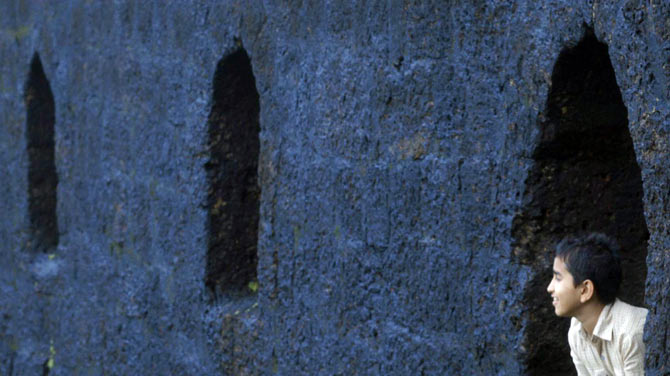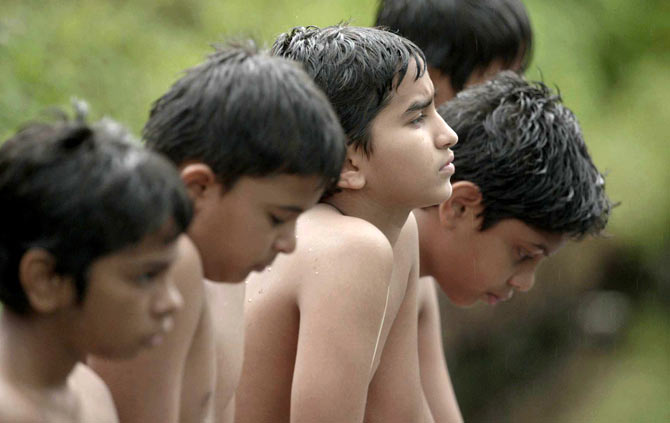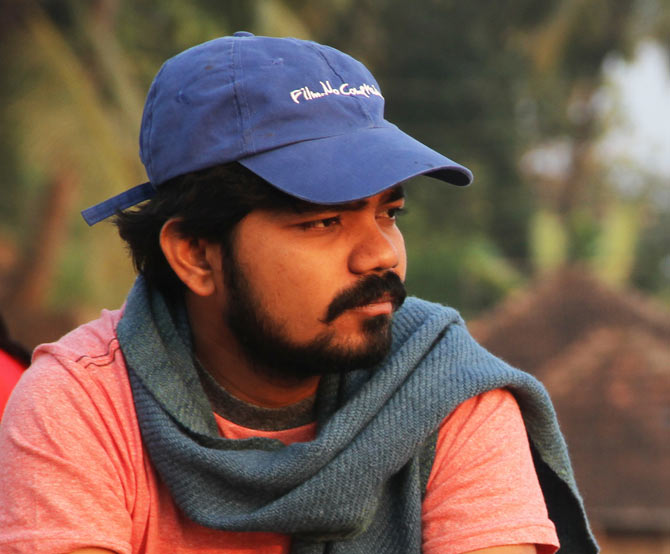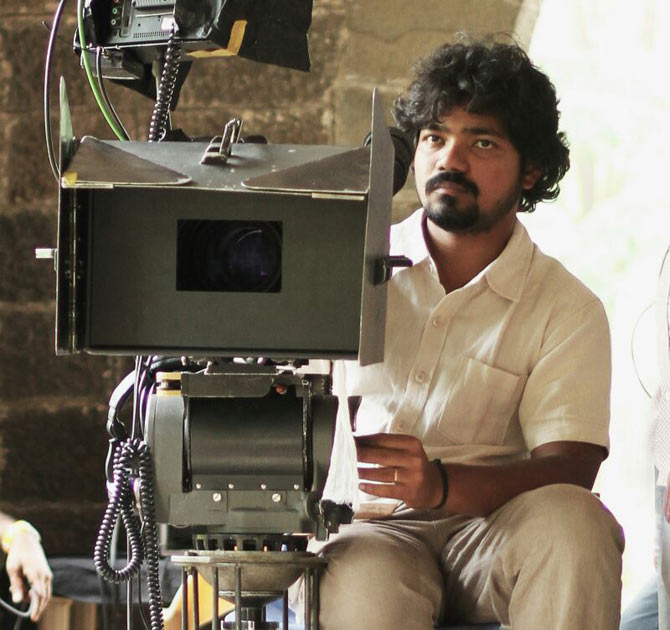 | « Back to article | Print this article |
'This is the second generation of my family that has gotten education'
Avinash Arun, winner of the Crystal Bear at Berlinale for his directorial debut, Killa, shares a fascinating life story with Aseem Chhabra.
Killa, a small Marathi film made for children, made a splash at the Berlin International Film Festival this month.
Directed by Avinash Arun, a 28-year-old graduate of the Film and Television Institute of India, it won the Crystal Bear for best film in the Generation Kplus category. The film also received a special mention by the International Generation Kplus jury.
The jury made up of German children wrote this about Killa: 'This film convinced us in all respects: With… good camera work and the great actors, but also because of its incredibly beautiful nature images which blend perfectly with the music. This film made us all want to discover India.'
And the international jury added, 'A beautifully photographed story about the challenges of being a boy. This film had wonderful pace and rhythm. Never reverting to clichés, the fresh performances left us feeling we were right there with the characters.'
The heartwarming Killa focuses on a young boy Chinmay, and the year he spends in a village in Maharashtra, making new friends, while also caring for his single mother.
The film had three sold out performances at Berlinale, attended mostly by German school children who seemed very engrossed with the story.
Arun spoke to Aseem Chhabra in Berlin the day before the awards were announced.
Please click NEXT to read further...
'I have experienced almost all the incidents in the film'
How did this project start? Where did this idea come from?
I was born in Solapur in Maharashtra and in a small family. This is the second generation that has gotten education. My mother still doesn't know what I do.
Really? But she has seen films on television?
She has seen films and there is TV at home. But she is not interested. And no one else has this background in my family. But because of my father's job I started traveling to places.
What does your father do?
He was a government servant, but now he has retired.
From Solapur which is in the southern part of Maharashtra, my childhood was spent in the Konkan region, which is in the western part of Maharashtra, and then in Pune.
Every time I used to change schools. Each time I had to make new friends and there would be a different culture.
So with all of these changes, I developed a unique sort of understanding.
These were the experiences that I wanted to share in my first film. I have experienced almost all the incidents in the film. Of course I fictionalised a little bit and added some drama to the script.
'I have lived on Bollywood films'
What kind of films had you been watching? I know there are so many exciting films being made in Marathi and you thank Umesh Kulkarni (director, Vihir) in the beginning of the film. But what inspired you to make a film with this quiet cinematic language?
Definitely Umesh Kulkarni is my mentor. I was his assistant. What Umesh has done for Marathi cinema is remarkable. But otherwise I have lived on Bollywood films -- works of Guru Dutt sahib and others.
But this is not a Bollywood film…
Yes it is not.
When I joined the institute (FTII) I started watching different cinemas.
I loved watching Ingmar Bergman’s films, how he explored intimate relationships. His canvas would often be small, but he really explored the complexities of human relationships in such subtle ways.
Those are the kind of subjects that pleased me a lot.
I studied cinematography at FTII. I did want to make a film, but I had no idea it would happen so soon; I graduated from FTII in 2011.
And you have shot some films?
I shot a Marathi film for NFDC (National Film Development Corporation of India) and currently I am shooting Nishikant Kamat’s film with Irrfan Khan (reportedly titled Dangal).
Meanwhile, I have shot shorts for Anurag Kashyap, Umesh and other young filmmakers.
But I have been very choosy about feature films.
'I had worked on Kai Po Che as an assistant cinematographer'
So how did Killa come to you so soon?
I had worked on Kai Po Che as an assistant cinematographer.
I met Ajay Rai there. He was the executive producer. We had developed a rapport. He later called me for a cinematography job and we talked about this idea I had. I started narrating the story of Killa.
Had you written a script?
No. I got nervous, and after 10-15 minutes of the narration I felt it wasn't going well.
But he wanted me to complete it. He then called his partner Alan McAlex and I got to narrate my story again.
Ajay told me that they liked the story and they wanted me to shoot by June or July since the monsoon plays a big role in the film. We were in March. So I said 'What are you saying? We don't have a script.'
Ajay was confident and said 'Script will happen, since you have the story.'
Meanwhile, one thing I had done was that I had spoken to a junior at FTII. I had signed him a check and he had written a 40-pages treatment. I thought it would take a couple of years to write the script and then get financing. I knew that this would be a Marathi film. I was very sure of my market.
So I called the screenplay writer friend and in two nights we cracked the plot and we started writing. I got another friend to join so there were three of us (Arun, Omkar Achyut Barve and Tushar Pranjpe) who wrote the final script.
I knew exact locations where I wanted the film to be shot. That helped me write the script.
'My instincts worked with these young actors'
Where is the fort located? And the beach where the kids hang out?
The fort is in Vijaydurg. The beach is in Guhagar.
And these are near Ratnagiri?
The beach is in Ratnagiri District. The fort is in Sindhudurg District.
The beach scenes are lovely. Very rarely you see in Indian films children sitting and staring at the waves. It was very moving.
How did you get your actors? They were so natural. I am sure they must have grown up watching Bollywood films, so it must have been hard to get them to act so naturally.
I am from Pune and we have a lot of cultural activities there.
The actor who played Bandya (a young school kid who is always making jokes in the film), I had worked him before. He is older than the other kids, but he is short otherwise. He is intelligent, so I definitely wanted to work with him.
What I liked about Archit Deodhar (the protagonist Chinmay) is that he is a very poised actor; he could hold the scene without doing anything.
I wanted an actor who could hold the frame even when he is standing and not doing anything. Archit reminded me of the way I was as a child.
My instincts worked with these young actors.
'Our main goal was to get the essence of the monsoons'
Did you conduct workshops with the kids at all?
We had very little time, but yes we did. My friend Omkar Barve did the casting and Sarang Sathe conducted the workshops. He is a seasoned theater actor.
You said at the post-screening Q&A that the shoot was for 28 days and you were able to capture the monsoon season…
Yes, our main goal was to get the essence of the monsoons. Although we had to constantly fight with the rains, and then we couldn't shoot for long hours with children.
I think the fort sequence is the heart of the film. It is breathtaking and brings in so many elements of childhood -- the friendships, the fear of being alone in a new place.
From the very beginning I was clear that the fort scenes had to work, otherwise the film would lack its focus.
So, I shot that scene in the beginning. I knew it would take a couple of days to shoot it, although our budget was tight. I shot it on new Canon 4K DSLR camera. I took the camera with an eight-member crew, including the actors and we shot it for three days.
The first day there was no rain and I was so frustrated. I was so concerned that if this sequence would not work there would be no film and I would have to shelve it.
If you are shooting the most crucial sequence of the film and if you don't get it right, then what's the point of making this film?
But the rain gods heard me. The weather department had predicted heavy rains in the next 48 hours. I took Archit with me for the next few days and we kept shooting in the rain. At the end I was so happy.
I messaged Umesh that I have a film in my hand.
'I couldn't sit by the monitor and direct'
How does it work when you make your first feature where you are the cinematographer as well as the director?
When I started working on the film, a few people warned me that it would be difficult to shoot it while also being the director.
But I told them that… when I would be in trouble this is the only thing that would rescue me. I was so sure of it.
I couldn't sit by the monitor and direct.
That would have been an entirely different experience for me, and I didn't have that much of time.
Cinematography is in my system. So I can tell how good or bad a frame looks. I was very confident of that part. But I could only see the entire energy of the shots, including the performances through the camera.
It worked out.
It must have been a wonderful experience to watch the film with children at the Berlinale.
Yes, I was so surprised.
Because you can't buy children’s emotions. Because if they like it then it is good, but if they don't then they will not focus on the film.
And they asked such amazing questions such as why there was no happy ending?






